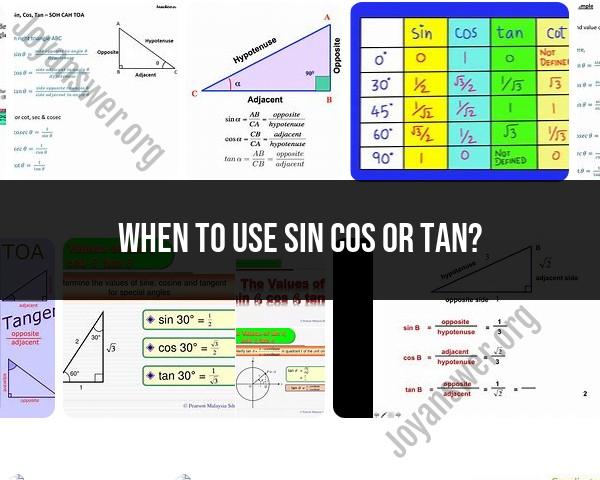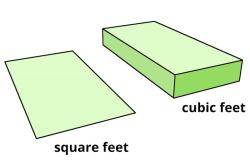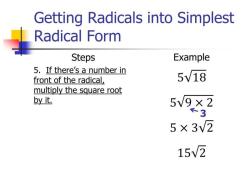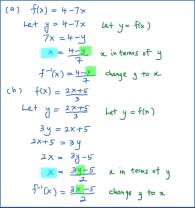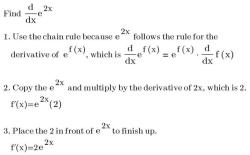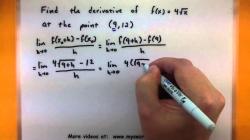When to use sin cos or tan?
The choice between sine (sin), cosine (cos), and tangent (tan) in trigonometry depends on the specific problem or application you are dealing with. Each trigonometric function has its own characteristics and is useful in different situations. Here's a general guide on when to use each:
Sine (sin):
- Use sine when dealing with the vertical component of a right-angled triangle.
- Sine is often used in problems involving height, displacement, or motion along a vertical axis.
Cosine (cos):
- Use cosine when dealing with the horizontal component of a right-angled triangle.
- Cosine is commonly used in problems involving distance, displacement, or motion along a horizontal axis.
Tangent (tan):
- Use tangent when dealing with the ratio of the vertical side to the horizontal side of a right-angled triangle.
- Tangent is often used in problems involving slopes, angles of elevation or depression, and in navigation.
In summary:
- Use sine (sin) for problems involving vertical components.
- Use cosine (cos) for problems involving horizontal components.
- Use tangent (tan) for problems involving the ratio of vertical to horizontal components.
It's important to note that these functions are most commonly used in the context of right-angled triangles. In more advanced trigonometry and calculus, these functions are extended to non-right-angled triangles and circles, and their applications become more diverse. Understanding the context of the problem and the geometric relationships involved will help you choose the appropriate trigonometric function for a given situation.
In what situations would one use sine, cosine, or tangent functions?
Sine, cosine, and tangent are the fundamental trigonometric functions used in a wide range of fields. Here are some common situations where you would encounter these functions:
Science and Engineering:
- Motion analysis: Sine and cosine are used to describe periodic motion, such as the motion of a pendulum or a wave. Tangent is used to calculate the slope of a curve at a particular point, which is useful for analyzing acceleration and other rate-of-change phenomena.
- Projectile motion: Calculating the trajectory of a projectile involves using sine and cosine to resolve the initial velocity into horizontal and vertical components.
- Forces and angles: Analyzing forces acting on objects at angles requires using sine and cosine to resolve the forces into their components.
- Circuit analysis: Sine and cosine functions are used to represent alternating current and voltage in electrical circuits.
- Signal processing: Analyzing and manipulating signals in various fields, like audio, image processing, and communication systems, often rely on trigonometric functions.
Mathematics:
- Geometry: Calculating side lengths and angles in triangles and other geometric shapes involves using sine, cosine, and tangent.
- Trigonometric identities: These are equations that relate sine, cosine, and tangent to each other, and they are used to solve various trigonometric problems.
- Calculus: Understanding derivatives and integrals of trigonometric functions is crucial for advanced mathematical analysis.
Navigation and Surveying:
- Calculating distances and directions between points on Earth's surface involves using trigonometric functions to account for the curvature of the planet.
- Determining the position of ships and aircraft also relies on trigonometry.
Computer Graphics:
- Rendering realistic 3D graphics involves using trigonometric functions to perform various transformations and calculations related to lighting, shadows, and perspective.
Music:
- Understanding the harmonic relationships between notes and chords involves using trigonometric functions to analyze musical intervals and scales.
Other Fields:
- Economics: Analyzing economic cycles and trends sometimes involves using sine and cosine functions to model periodic fluctuations.
- Finance: Calculating interest rates and other financial metrics often rely on trigonometric functions.
- Medicine: Analyzing medical images and signals, such as electrocardiograms and brain scans, can involve the use of trigonometric functions.
These are just a few examples, and the specific applications of sine, cosine, and tangent functions extend far beyond this list. As a general rule, any situation requiring calculations involving angles, periodic motion, or the resolution of quantities into components will likely involve these fundamental trigonometric functions.
